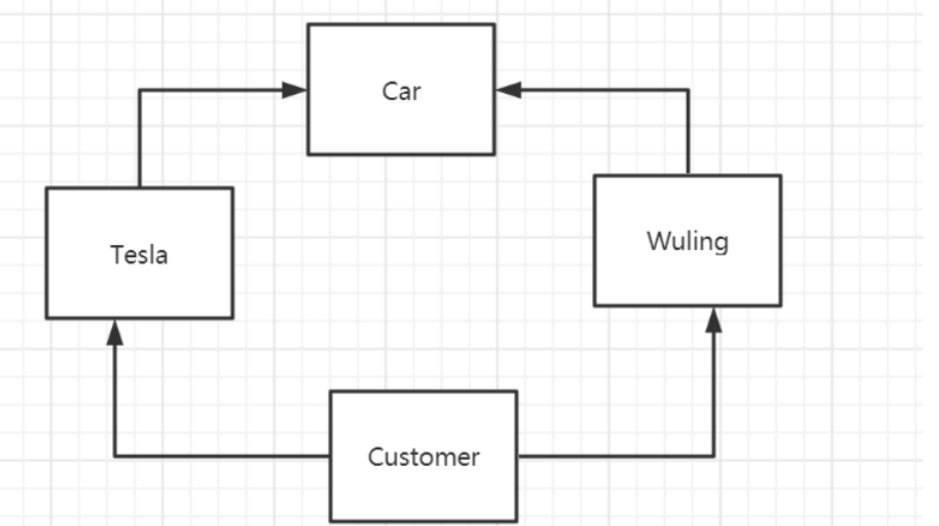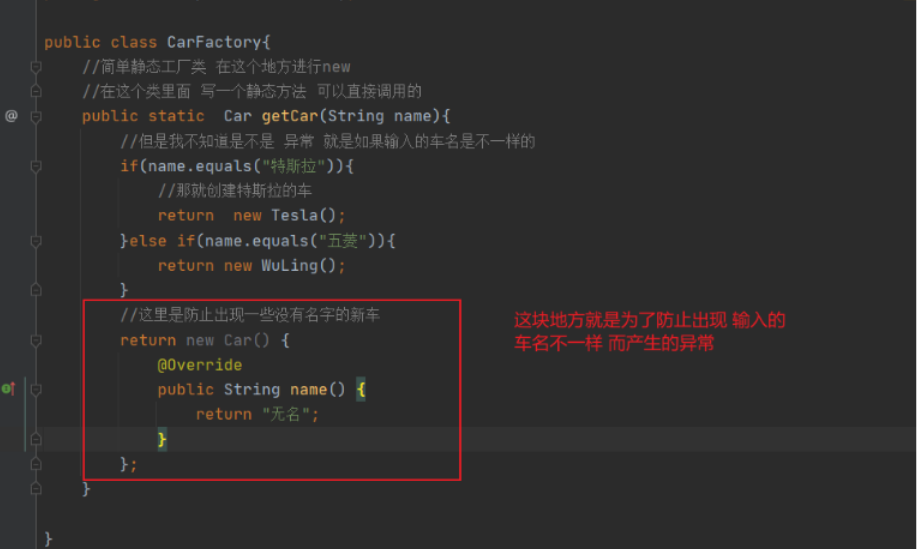It is also called static factory mode. In fact, it does not belong to 23 design modes.
His realization is mainly
Define a class that dynamically determines which instance of a product class (which inherits from a parent class or interface) should be created according to the passed in parameters. In fact, the instantiation of a specific class is handed over to the static method of a class for execution (which reflects the separation of creator and caller). This class is called factory class, and the static method is called static factory method.
First, take buying a car as an example to create a familiar process
Create an interface first:
public interface Car {
//Property with a name
String name();
}
Then create two entity classes:
Tesla
public class Tesla implements Car{
@Override
public String name() {
return "Tesla";
}
}
Wuling
public class WuLing implements Car{
@Override
public String name() {
return "Wuling";
}
}
Create consumers to buy these two types of cars
public class Customer {
public static void main(String[] args) {
//Then as a consumer, if you need to buy a Wuling and a Tesla
//You need to create these two instance objects
Car car1=new WuLing();
Car car2=new Tesla();
System.out.println(car1.name());
System.out.println(car2.name());
}
}

However, there is a big disadvantage in this basic mode, that is, when instantiating an object, you need a new one, just like when buying a car, you need to create your own new car, so you need to have a factory class
Pattern diagram

Simple factory mode:
CarFactory
public class CarFactory{
//The simple static factory class is new in this place
//Write a static method in this class that can be called directly
public static Car getCar(String name){
//But I don't know if it's abnormal, that is, if the entered car name is different
if(name.equals("Tesla")){
//Then create Tesla's car
return new Tesla();
}else if(name.equals("Wuling")){
return new WuLing();
}
//Here is to prevent some new cars without names
return new Car() {
@Override
public String name() {
return "unknown";
}
};
}
}
FactoryCustomer
public class FactoryCustomer {
public static void main(String[] args) {
//Here is the factory
//Create this factory class first
Car car1=CarFactory.getCar("Tesla");
Car car2=CarFactory.getCar("Wuling");
Car car3=CarFactory.getCar("anonymous person");
System.out.println(car1.name());
System.out.println(car2.name());
System.out.println(car3.name());
}
}


However, this simple factory mode does not conform to the opening and closing principle, that is, when we have a new car, we need to add if judgment on the CarFactory side, so the simple factory mode is also a static factory mode. Not suitable for dynamic increase
Model diagram:

Factory method mode:
In fact, it is simply to define a factory interface, and then implement the factory interface for each vehicle to become its own car factory
Create Car interface first:
public interface Car {
//Property with a name
String name();
}
Tesla and WuLing are two implementation classes:
public class Tesla implements Car {
@Override
public String name() {
return "Tesla";
}
}
public class WuLing implements Car {
@Override
public String name() {
return "Wuling";
}
}
CarFactoryu interface
public interface CarFactory {
//This interface has a method
Car getCar();
}
Tesla factory interface and WuLing factory interface:
public class WuLingFactory implements CarFactory{
@Override
public Car getCar() {
return new WuLing();
}
}
public class TeslaFactory implements CarFactory{
@Override
public Car getCar() {
//Implement the factory interface and create a corresponding class
return new Tesla();
}
}
Finally, the customer class
public class Customer {
public static void main(String[] args) {
//So you need to connect with the corresponding factory? Anyway, the purpose is not to need new?
//Is this unnecessary
//But in this way, new can be understood as that a new car is equivalent to building a car, but a new factory is equivalent to finding a 4s store...
TeslaFactory teslaFactory=new TeslaFactory();
WuLingFactory wuLingFactory=new WuLingFactory();
Car car1=teslaFactory.getCar();
Car car2=wuLingFactory.getCar();
System.out.println(car1.name());
System.out.println(car2.name());
}
}
The advantage of this is that it meets the opening and closing principle and does not need to be modified. However, you need to add each time:

